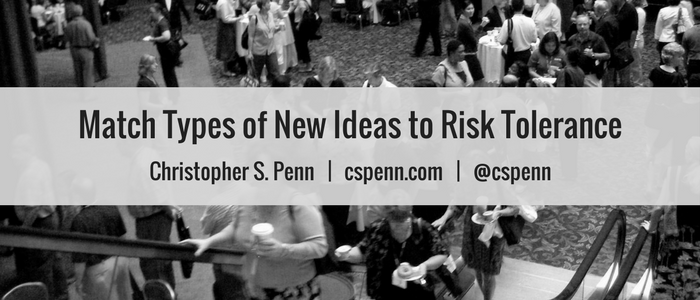
At this time of year – meaning year’s end – I often see marketers in search of “new ideas” and “fresh ideas”, especially when looking for new agencies or employees. Knowing what kind of organization we’re dealing with determines what kinds of new ideas we should be bringing to the table.
Three Kinds of New Ideas
When we ask for new, fresh ideas, what are we asking for?
Broadly, new ideas will fall into three buckets:
- Ideas you’ve never tried but others have succeeded with (“new to you”)
- Ideas you’ve tried and failed at, but others have succeeded with (“new perspective”)
- Ideas no one has imagined and no one has tried (“genuinely new”)
In risk-averse organizations, when someone asks for new ideas, they’re really asking for category 1, “new to you” ideas. They’re looking for ideas which have a proven track record elsewhere, so that their exposure to risk is minimal. They can point to a case study or an award as justification for the “new idea”.
In risk-tolerant organizations, category 2, “new perspective”, becomes available. Risk-tolerant organizations are willing to admit they’ve been wrong in the past, and as long as an idea succeeded somewhere, they’ll take another chance. As with risk-averse organizations, the less risk-averse organization will still be looking for the case study or award to justify going back to a previously-failed idea.
In risk-friendly organizations, category 3, “genuinely new”, becomes available. Risk-friendly organizations are willing to try something that’s never been tried before. They’re willing to place a bet on the unknown, gambling that the idea will give them true competitive advantage. In the words of my friend and former colleague Todd Defren, they don’t want to read the case study – they want to be the case study.
What Kind of Organization?
To know what kinds of new, fresh ideas to bring, we must know and understand the level of risk the organization tolerates.
- Bring “new to you” ideas to risk-averse organizations
- Bring “new perspective” ideas to risk-tolerant organizations
- Bring “genuinely new” ideas to risk-friendly organizations
Avoid mismatches!
- Risk-averse organizations have no interest in repeating failures or gambling on unknowns
- Risk-tolerant organizations don’t want to take extreme chances, but neither do they want to solely be copycats
- Risk-friendly organizations want true innovation and will spurn unoriginal ideas
By matching ideas with risk levels, we’ll succeed in adoption of our ideas.
You might also enjoy:
- You Ask, I Answer: Reliability of LLMs vs Other Software?
- Almost Timely News, January 14, 2024: The Future of Generative AI is Open
- Mind Readings: What Makes A Good Conference/Event?
- Almost Timely News: Recipes vs. Principles in Generative AI (2024-03-03)
- Mind Readings: Generative AI and Addition vs Substitution of Jobs
Want to read more like this from Christopher Penn? Get updates here:
 Take my Generative AI for Marketers course! |


Leave a Reply